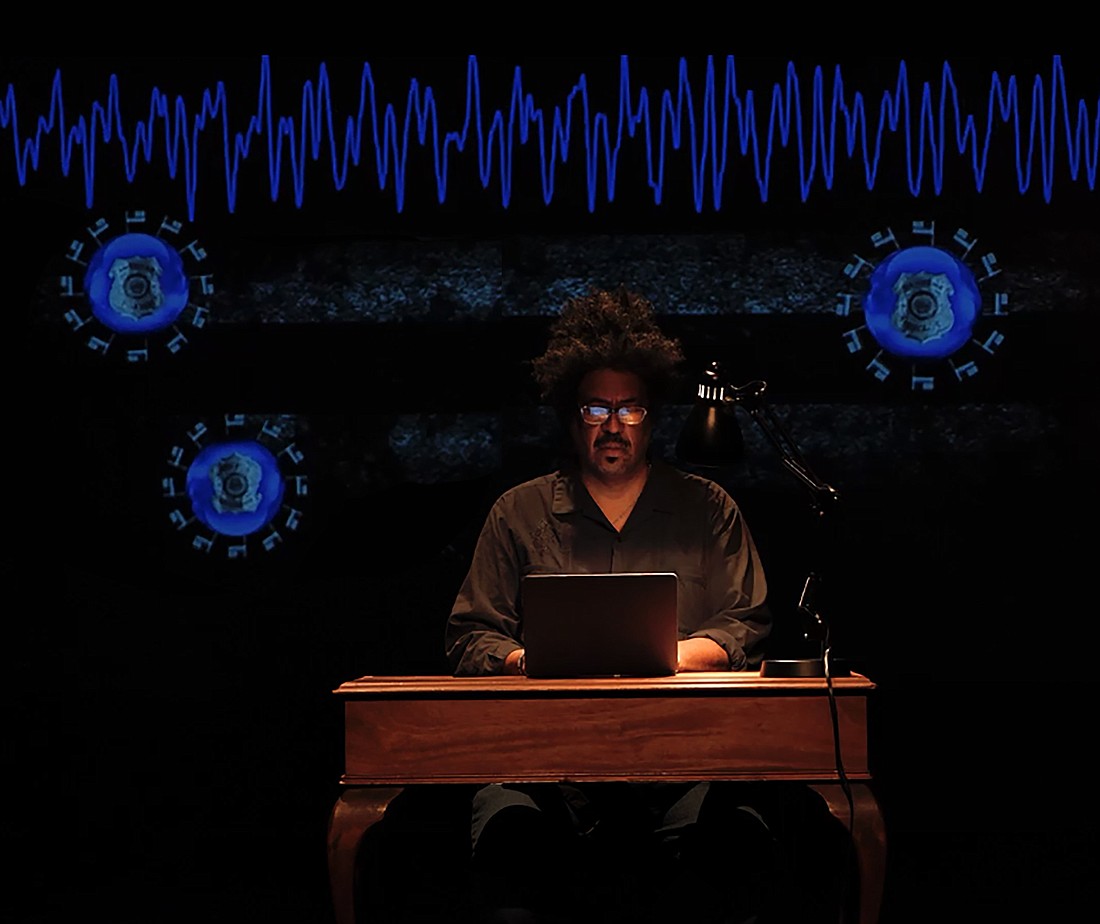- April 25, 2024
-
-
Loading

Loading

The Historic Asolo Theater is a gilt-edged rococo jewel box. The multitiered opera-shell auditorium was built in the 18th century in Asolo, Italy, and reassembled in the Ringling Museum in the 1950s. Looking up at the ornate proscenium arch, it’s easy to imagine you were back in the 1700s. Except for one glaring anachronism …
A massive Confederate flag draped above the stage. Not just any rebel flag, either. A flag in the black, green and red colors of African liberation — like an artifact from a parallel universe where an American slave revolt had succeeded. It sets the stage for an edgy, avant-garde drama. And John Sims is the author.
This Sarasota-based creator is primarily known as an African-American visual artist. But among other things, Sims is also a poet, a writer, a filmmaker, a music producer and a dramatist.
This “AfroConfederate” flag installation was originally meant to be revealed at the climax of Sims’ “(Di)Visions of America,” a multimedia stage production combining live and recorded performances. The pandemic forced a change. A one-time performance was staged without an audience, captured on film, and given limited release on streaming video.
In the Monda Gallery, Sims’ “Recoloration Proclamation” focuses specifically on his 20-year project to desecrate, and deconstruct the Confederate Flag at exhibits and events throughout America.
The strategy here is pure artistic Aikido. It’s Sims’ twist on fighting fire with fire. He’s fighting racist drama with his own drama.
Racist power thrives on theatrics, after all. Hitler tops the list—but American idiots also make the scene. Our die-hard devotees of white supremacy are like a traveling theater troupe with a trunk full of Confederate flags, burning crosses, and men on horseback dressed up like ghosts. The props and costumes feed an inflated sense of self as part of a superior group. They’d be funny, if they weren’t so deadly.
Sims flips the script and robs racist drama of its power. Under Sims’ direction, Ally Couch sings “Dixie” in the style of Billie Holiday’s “Strange Fruit.” The Confederate flag itself is lynched. Sims’ fiery poetry turns “Amazing Grace” into “A Blazing Grace” — a call to burn and bury the damn thing, and all it represents. It’s a powerful message, assuming our homegrown Hitlers would ever watch this video. Since they probably won’t, who’s his target audience?
Sims’ “(Di)Visions of America” answers that question.
There’s some overlapping content with “The Recoloration Proclamation.” Sims’ message is loud and clear. Racism is bad. Aside from extremist militia groups, neo-Nazis, and conspiracy nuts, most Caucasian-Americans would agree. Racism is bad. Yep. That’s obvious. So obvious, it’s invisible …
To, say, comfortable liberals like yours truly who do watch the video.
We have met the audience, and it is us.
People like me don’t see the racist implications all around us. The statue of a Confederate general over here. That Rebel flag decal on the pickup truck over there. This stuff is all around us. We’ve seen it our whole lives. As a result, we stop seeing it. It’s just visual noise. A blur in the background.
By flipping the script, Sims makes it visible again.
“DiVisions of America” works like the sunglasses in John Carpenter’s “They Live.” It lets you see the subliminal messages all around you. White supremacy pops into crystal clear focus, with all of its ugly street theater.
First you see it. And then you see through it.
Behind the flags and statues, you see the deeper issues. And it’s everything that sent the Black Lives Matter movement into the streets …
Police brutality. Racist medical policies in a time of pandemic. Institutional racism. White-washed historical amnesia.
Sims’ conceptual X-ray makes this all visible through his own poetry, and impassioned spoken-word performances by Dr. Lisa Merritt and others. Once you see it, what can you do about it?
That’s up to the viewer. But turning away is a bad idea. And claiming you don’t want to dwell on the past is a bad excuse.
To quote William Faulkner, “The past is never dead. It's not even past.”
That applies to America’s racist past.
It’s not dead. It’s not even past.
Sims completed work on “(Di)Visions of America” as part of his 2020-2021 residency at The Ringling. Sims’ “Recoloration Proclamation, 2020” is part of The Ringling’s “For Real This Time” exhibition featuring films and video by seven artists on race, history and social justice.